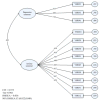Examining the Factor Structure of Anxiety and Depression Symptom Items Among Adolescents in Santiago, Chile
- PMID: 21785669
- PMCID: PMC3140221
- DOI: 10.5243/jsswr.2011.1
Examining the Factor Structure of Anxiety and Depression Symptom Items Among Adolescents in Santiago, Chile
Abstract
The co-occurrence of emotional disorders among adolescents has received considerable empirical attention. This study aims to contribute to the understanding of co-occurring anxiety and depression by examining the factor structure of the Youth Self-Report used with a sample of low-income adolescents from Santiago, Chile. Data from two independent, randomly selected subsamples were analyzed using exploratory and confirmatory factor analyses. Results indicate the best fit for the data is a two-factor model of anxiety and depression symptoms, which factors anxiety and depression into separate latent constructs. Because the findings show that anxiety and depression are not measured by the same factor in this international sample, the results imply that a valid and useful distinction exists between these constructs. That these constructs are found to be separate factors suggests that anxiety and depression may have separate etiologies and consequences, which might be best addressed by separate intervention components. These findings are consistent with the viewpoint that anxiety and depression constructs have similar emotional features and, despite sharing a common underlying internalizing disorder, distinct items capture aspects of each construct.
Figures
Similar articles
-
Differential item functioning due to gender between depression and anxiety items among Chilean adolescents.Int J Soc Psychiatry. 2012 Jul;58(4):386-92. doi: 10.1177/0020764011400999. Epub 2011 May 31. Int J Soc Psychiatry. 2012. PMID: 21628359 Free PMC article.
-
A multi-group confirmatory factor analysis of the revised children's anxiety and depression scale (RCADS) in Spain, Chile and Sweden.J Affect Disord. 2022 Aug 1;310:228-234. doi: 10.1016/j.jad.2022.05.031. Epub 2022 May 10. J Affect Disord. 2022. PMID: 35561880
-
Sleepy, sluggish, worried, or down? The distinction between self-reported sluggish cognitive tempo, daytime sleepiness, and internalizing symptoms in youth with attention-deficit/hyperactivity disorder.Psychol Assess. 2019 Mar;31(3):365-375. doi: 10.1037/pas0000671. Epub 2018 Nov 8. Psychol Assess. 2019. PMID: 30407044
-
Behavioural modification interventions for medically unexplained symptoms in primary care: systematic reviews and economic evaluation.Health Technol Assess. 2020 Sep;24(46):1-490. doi: 10.3310/hta24460. Health Technol Assess. 2020. PMID: 32975190 Free PMC article.
-
Language disorder and internalizing mental health problems in youth offenders: A systematic review.Int J Lang Commun Disord. 2022 Nov;57(6):1207-1228. doi: 10.1111/1460-6984.12759. Epub 2022 Jul 16. Int J Lang Commun Disord. 2022. PMID: 35841339 Free PMC article.
Cited by
-
Differential item functioning due to gender between depression and anxiety items among Chilean adolescents.Int J Soc Psychiatry. 2012 Jul;58(4):386-92. doi: 10.1177/0020764011400999. Epub 2011 May 31. Int J Soc Psychiatry. 2012. PMID: 21628359 Free PMC article.
-
Alcohol, binge drinking and associated mental health problems in young urban Chileans.PLoS One. 2015 Apr 1;10(4):e0121116. doi: 10.1371/journal.pone.0121116. eCollection 2015. PLoS One. 2015. PMID: 25830508 Free PMC article.
References
-
- Achenbach TM. Integrative guide for the 1991 CBCL/4-18, YSR and TRF profiles. Burlington: University of Vermont, Department of Psychiatry; 1991.
-
- Achenbach TM. Empirically based taxonomy: How to use syndromes and profile types derived from the CBCL/4-18, TRF, and YSR. Burlington: University of Vermont; 1993.
-
- Achenbach TM, Becker A, Dopfner M, Heiervang E, Roessner V, Steinhausen HC, Rothenberger A. Multicultural assessment of child and adolescent psychopathology with ASEBA and SDQ instruments: research findings, applications, and future directions. Journal of Child Psychology and Psychiatry. 2008;49:251–275. doi: 10.1111/j.1469-7610.2007.01867.x. - DOI - PubMed
-
- Achenbach TM, Rescorla L. Manual for the ASEBA School-Age Forms and Profiles. Burlington: University of Vermont, Research Center for Children, Youth, and Families; 2001. Retrieved from http://www.aseba.org/index.html.
Grants and funding
LinkOut - more resources
Full Text Sources


